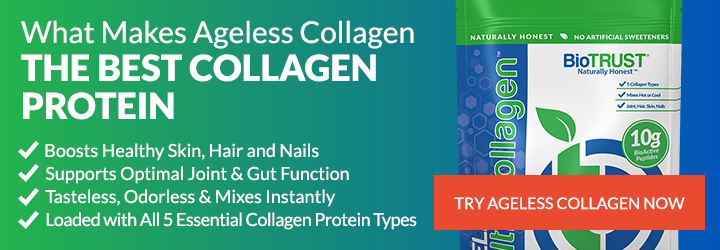How to Improve Bone Density at Any Age (in 4 Easy Steps)

Bones are the very foundation of a strong, healthy body throughout life—from early childhood through the teens and 20s and maintained into the golden years. Bones typically reach their maximum strength and density by the time we hit 25 to 30 years old, a point known as peak bone mass, which is usually maintained for the next couple of decades. Fortunately, when it comes to how to improve bone density and build healthy bones, there are steps we can take at any age. The key is to have a bone-density action plan.
Earlier in life, it’s essential to beef up bone mass, so you have a bigger bone bank, so to speak, as you age. Once over 30, it’s time to shift the goal to maintaining the bone you have (i.e., prevent the loss of bone). That said, throughout life, bone continues to remodel—breaking down and rebuilding, bit by bit. So, no matter what your age, you can improve bone density. Here’s how…
How to Improve Bone Density: 4 Easy Steps
1. Bone Up on Nutrition
You’ve probably heard by now that calcium is key for bone health. 1 And calcium is a vital mineral for the development of bones and teeth. (It’s also needed for muscle and nerve function, hormone secretion, and blood pressure.)
Food sources of calcium include dairy (e.g., milk, yogurt, cheese) as well as canned salmon with bones, sardines, spinach, collard greens, dried figs, white beans, chia seeds, and amaranth. The best way to ensure that you absorb the majority of calcium you eat is by consuming it throughout the day rather than getting it all in one meal.
Calcium isn’t the only important bone-building nutrient. Vitamin D helps the body better absorb calcium for stronger bones. 2 The best way to get vitamin D is by exposing the skin to the sun for 10 to 15 minutes at least 3 times a week. You can also get vitamin D from sardines, egg yolks, tuna, or a vitamin D supplement, which is essentially a necessity for the majority of people from November through April (if not all year long).
Before getting on a vitamin D supplement, however, it’s best to check with a doctor as it is possible to build up a bank of vitamin D with seasonal sun exposure alone. However, many people need to supplement during the winter to help prevent bone loss. 2
Another critical nutrient to build healthy bones is vitamin K, which is necessary to ensure that the body properly uses all that calcium, which vitamin D helped soak up, to build those strong, healthy bones. 3 All three nutrients—calcium, vitamin D, and vitamin K—work together to support bone density. Some good sources of vitamin K include broccoli, Swiss chard, kale, and spinach. Foods that are particularly high in vitamin K2, which tends to be better absorbed than other plant-based foods (which contain K1), are sauerkraut, cheese, and natto.
Another key vitamin for bone health is vitamin C as it stimulates the production of cells that form bones and may protect bone cells from damage. 4 In addition to citrus fruits (like oranges and grapefruits), bell peppers, broccoli, cauliflower, strawberries, kiwifruit, and tomatoes are all good sources of vitamin C.
While it’s not as well known for bone health, potassium is another important mineral. This is because potassium may neutralize acids that can decrease calcium in the body. One study found that women who had the highest intake of potassium had eight percent greater bone density compared to those with the lowest potassium intake. 5 Foods high in potassium include avocados, sweet or white potatoes (with the skin), yogurt, zucchini, spinach, white and black beans, butternut squash, and of course, bananas.
Zinc and magnesium are two other vital minerals to improve bone density. Magnesium is required to help activate vitamin D’s ability to promote calcium absorption. Meanwhile, zinc is a component of bone and is needed for bone growth and to prevent bone breakdown. Foods that provide both of these key minerals include nuts, legumes, seeds, and whole grains.
In other words, a well-balanced diet that’s heavy on vegetables, fruits, fish, dairy and minimally processed plant-based foods can support healthy bones. 6
2. Bone Up with Exercise
Of course, exercise keeps your muscles strong and fit, but did you know it’s just as important for building bone density? 7 Naturally, you may be wondering, “What’s the best type of exercise?” Anything that’s weight-bearing, such as, walking, running, hiking, skiing, dancing, jumping rope, and stair climbing can boost bone health. 8
Resistance training (i.e., lifting weights) is another powerful bone builder. 9 – 11 Strength training can help stimulate new bone growth as well as improve bone density. Bonus: the increased strength and balance achieved with regular exercise also helps prevent falls, and thus, bone breaks.
If you still find yourself couch surfing a bit too much, building bone health is yet another reason to make fitness a priority as a sedentary lifestyle is strongly associated with weaker bones. 12
3. Maintain Bone Health with a Healthy Weight
Underweight individuals are at a higher risk for bone issues, 13 and people who weigh too much experience bone stress. 14 So, when it comes to weight, it’s most important to have a healthy balance. 15 Research also suggests rapid weight loss or yo-yoing between extremes of gaining and losing weight can negatively affect bone density. 16
If you need to lose (or gain) weight, do so gradually and avoid crash diets, which may lead to bone loss. It’s also important to consume enough protein as this macronutrient is key for bone and muscle density. Eating enough protein has even been found to boost overall bone density. 17 Collagen protein specifically is being researched for its potential positive effect on bone density, which makes sense given collagen’s important role in bone structure and metabolism. 18, 19
Fat, more specifically omega-3 fatty acids, is also vital for both healthy weight and bone density.
4. Put the Brakes on Bone Breakdown
Now that you know how to improve bone density, the other side of the coin is preventing excess breakdown of bone. As mentioned, bone is constantly being remodeled, so some breakdown is not just normal, it’s completely healthy. However, when bone breakdown exceeds bone formation, it can be problematic. Along those lines, some common habits that can lead to bone loss include:
• Too much caffeine consumption, which can interfere with calcium absorption and negatively interact with vitamin D. For bone density, cut down to less than 300mg per day, especially if you’re at risk for not getting enough calcium from your diet. 20, 21
• Heavy alcohol consumption, which can also negatively interfere with vitamin D absorption. You don’t need to stop drinking completely, however, as moderate drinking has been shown to be a-okay for bone health. Just keep it down to no more than one drink per day for women and two per day for men. 22, 23
• Smoking cigarettes. If we didn’t have enough reasons to support stop smoking campaigns, here’s another one. Study after study shows that smoking can decrease bone mass by reducing calcium absorption. 24, 25
• Slamming soda. If you have a soda habit you’ve found hard to break, now’s a good time to set it to the side and reach for another tasty beverage instead. (May we suggest water?) The sugar, caffeine, and phosphoric acid in sodas have been linked to decreased bone minerals and increased risk of fractures. 26 – 28 More research is needed, but there are enough drawbacks of drinking sodas to go ahead and give it up or at least reduce consumption. Note that the same does not seem to be true for other carbonated soft drinks, which have not been shown to be associated with lower bone mineral density.
• Eating disorders. People who suffer from anorexia or bulimia are also at a higher risk for bone loss. Those with certain gastrointestinal conditions (e.g., Chrohn’s disease, Cushing’s, or celiac) are also at a higher risk as are people who have weight-loss surgeries. All of these can negatively affect the consumption and absorption of bone-building nutrients like calcium and vitamin D.
Improving bone density is a lifelong endeavor that’s important at every age. Fortunately, there are simple action steps you can take to “bone up”—including following a healthy diet (heavy on the vegetables), regular exercise, and avoiding habits that lead to excess bone breakdown.








